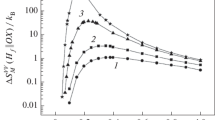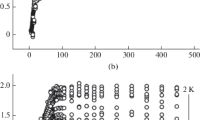Abstract
The changes in magnetic entropy upon isothermal magnetization of a uniaxial paramagnet with Kramers ions (spin S = 3/2) and single-ion easy-plane anisotropy were studied at low temperatures. It was demonstrated that the magnetocaloric effect upon magnetization in the easy direction is considerably stronger than the one corresponding to magnetization in the hard direction (perpendicular to the easy plane). It was found that magnetization in the hard direction is accompanied by an anomalous increase in magnetic entropy in a finite interval of magnetic fields. A nonmonotonic dependence of entropy on the final magnetization field is produced as a result.


Similar content being viewed by others
REFERENCES
K. A. Gschneider, Jr., V. K. Pecharsky, and A. O. Tsokol, “Recent developments in magnetocaloric materials,” Rep. Prog. Phys. 68, 1479–1539 (2005).
A. M. Tishin, “Magnetocaloric effect: current situation and future trends,” J. Magn. Magn. Mater. 316, 351–357 (2007).
N. A. Oliveira and P. J. von Ranke, “Theoretical aspects of the magnetocaloric effect,” Phys. Rep. 489, 89–153 (2010).
V. Franco, J. S. Blazquez, P. Ingale, and A. Conde, “Magnetocaloric effect and magnetic refrigeration near room temperature: materials and models,” Annu. Rev. Mater. Res. 42, 305–342 (2012).
Z. Wei, A. Chak-Tong, and D. You-Wei, “Review of magnetocaloric effect in perovskite-type oxides,” Chin. Phys. B. 22, 057501 (2013).
N. R. Ram, M. Prakash, U. Naresh, N. S. Kumar, T. S. Sarmash, T. Subbarao, R. J. Kumar, G. R. Kumar, and K. C. B. Naidu, “Review on magnetocaloric effect and materials,” J. Supercond. Novel Magn. 31, 1971–1979 (2018).
E. Ambler and R. P. Hudson, “Magnetic cooling,” Rep. Prog. Phys. 18, 251–303 (1955).
S. A. Al’tshuler and B. M. Kozyrev, Electron Paramagnetic Resonance of the Compounds of Intermediate Groups (Nauka, Moscow, 1972).
K. Taylor and M. Darby, Physics of Rare Earth Compounds (Wiley, London, 1972; Mir, Moscow, 1974).
A. H. Cooke and H. J. Duffas, “The paramagnetic resonance spectra of some rare-earth double nitrates,” Proc. R. Soc. A229, 407–415 (1955).
E. E. Kokorina and M. V. Medvedev, “Inverse magnetocaloric effect in the uniaxial paramagnet with non-Kramers ions,” Phys. Met. Metallogr. 118, 217–226 (2017).
Funding
This study was supported in part by project no. 18-2-2-1 of the Ural Branch of the Russian Academy of Sciences and grant no. 18-02-00281 from the Russian Foundation for Basic Research.
Author information
Authors and Affiliations
Corresponding authors
Additional information
Translated by D. Safin
Rights and permissions
About this article
Cite this article
Kokorina, E.E., Medvedev, M.V. Specific Features of the Magnetocaloric Effect in a Uniaxial Paramagnet with Kramers Ions. Phys. Metals Metallogr. 120, 925–929 (2019). https://doi.org/10.1134/S0031918X19100053
Received:
Revised:
Accepted:
Published:
Issue Date:
DOI: https://doi.org/10.1134/S0031918X19100053




